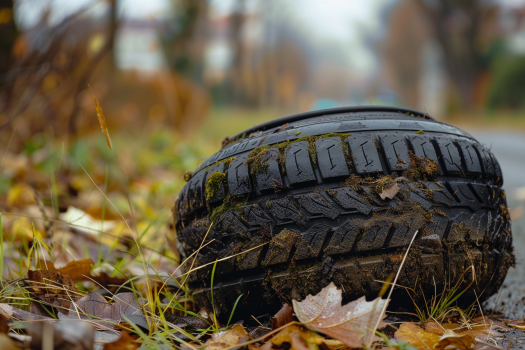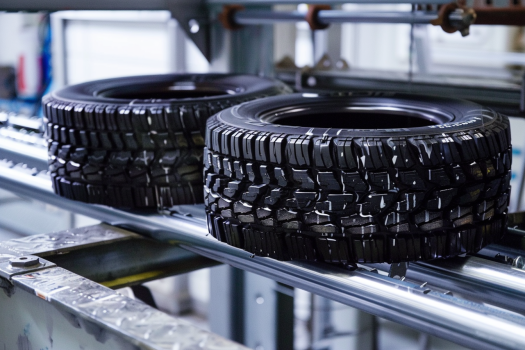Last Updated on 4 months
Introduction to Puncture-Resistant Tires
Tires are critical to any vehicle, providing the essential connection between your car and the road. When it comes to trucks and automobiles, tire durability and reliability are paramount. This section introduces puncture-resistant tires, highlighting the importance of tire durability and shedding light on common causes of tire punctures.

The Significance of Tire Durability
Tire durability refers to a tire’s ability to withstand various forms of wear, stress, and external factors while maintaining optimal performance. In the context of puncture-resistant tires, durability takes on added importance. here is why it matters:
- Enhanced Safety: Durable tires are less likely to fail on the road, reducing the risk of accidents caused by tire blowouts or flats.
- Cost Savings: Long-lasting tires mean fewer replacements, translating into cost savings for vehicle owners.
- Improved Performance: Durable tires maintain performance characteristics, such as traction and handling, over an extended lifespan.
- Reduced Downtime: Reliable tires lead to less downtime due to tire-related issues, benefiting commercial vehicle operators and individuals alike.
To achieve exceptional durability, puncture-resistant tires employ specialized construction and materials designed to withstand various challenges, from rough road surfaces to sharp objects like nails and debris.
Common Causes of Tire Punctures
Despite advancements in tire technology, tire punctures remain a common issue for vehicle owners. Understanding the typical causes of tire punctures is essential:
- Road Hazards: Sharp objects like nails, screws, glass, and rocks on the road can puncture tires when driven over.
- Underinflation: Insufficient tire pressure makes tires more susceptible to damage, as they lack the necessary rigidity to resist punctures.
- Overloading: Exceeding a tire’s load capacity can lead to excessive stress, increasing the risk of a blowout or puncture.
- Age and Wear: As tires age and tread wear down, they become more vulnerable to punctures.
- Improper Maintenance: Neglecting regular tire maintenance, such as checking for proper inflation and inspecting for damage, can contribute to punctures.
Introducing puncture-resistant tires emphasizes the critical importance of tire durability for safety, cost savings, and performance. It also provides insights into the common causes of tire punctures, highlighting the need for puncture-resistant solutions. As we delve deeper into the world of puncture-resistant tires, we will explore the types, their benefits, and how they work to keep your journeys smooth and nail-free.
Types of Puncture-Resistant Tires
When it comes to puncture-resistant tires, there isn’t a one-size-fits-all solution. Manufacturers have developed various puncture-resistant tires to cater to different needs and preferences. This section will explore the three main types of puncture-resistant tires: run-flat tires, self-sealing tires, and puncture-proof inserts.
Run-Flat Tires
Run-flat tires are engineered to allow you to continue driving even after a puncture. They are designed with reinforced sidewalls that can support the vehicle’s weight, even when the tire has little or no air pressure. Here is what you need to know about run-flat tires:
- Safety: Run-flat tires provide enhanced safety by allowing you to maintain control of your vehicle in the event of a puncture, reducing the risk of accidents caused by sudden blowouts.
- Convenience: With a run-flat tire, you can drive for a limited distance (typically 50 miles) at reduced speeds, giving you time to reach a safe location for repairs or replacement.
- Special TPMS: Run-flat tires often require a unique Tire Pressure Monitoring System (TPMS) to alert you when a tire is losing air.
While run-flat tires offer added safety and convenience, they may have a slightly firmer ride due to their reinforced sidewalls. They follow the manufacturer’s guidelines for repair or replacement after a puncture, which is essential.
Self-Sealing Tires
Self-sealing tires feature an innovative technology that automatically seals small punctures as they occur. These tires are typically filled with a sealant that coats the inside of the tire and seals punctures upon contact with a foreign object. Here is what you should know about self-sealing tires:
- Immediate Repair: Self-sealing tires provide instant repair for minor punctures, preventing air loss and maintaining proper tire pressure.
- Limited Repairable Size: The sealant is effective for small punctures, typically up to 1/4 inch in diameter. Larger punctures or cuts may require additional repair.
- Reduced Maintenance: Self-sealing tires lessen the need for frequent maintenance related to minor punctures.
Puncture-Proof Inserts
Puncture-proof inserts are an aftermarket solution designed to make existing tires puncture-resistant. These inserts are placed inside the tire, forming an additional protective layer. Here is what you should know:
- Universal Compatibility: Puncture-proof inserts can be added to most types and sizes of tires, making them versatile.
- Enhanced Protection: Inserts provide an added layer of protection against punctures from nails, screws, and other road hazards.
- Maintained Ride Comfort: Unlike some other solutions, puncture-proof inserts typically don’t significantly affect ride comfort or handling.
Puncture-proof inserts are a cost-effective way to upgrade your existing tires to be more puncture-resistant, extending their lifespan and reliability.
There are several types of puncture-resistant tires, each offering unique advantages. Run-flat tires provide safety and convenience, self-sealing tires offer instant repair for minor punctures, and puncture-proof inserts enhance protection for existing tires. Choosing the right type depends on your driving needs and preferences. In the following sections, we will explore the benefits of puncture-resistant tires and how they work to keep you on the road with confidence.
Benefits of Puncture-Resistant Tires
Puncture-resistant tires offer a range of advantages that contribute to a safer, more cost-effective, and convenient driving experience. This section will delve into the key benefits of choosing puncture-resistant tires for your vehicle.
Enhanced Safety on the Road
One of the primary advantages of puncture-resistant tires is the enhanced safety they provide while driving. here is how they contribute to safer journeys:
- Reduced Risk of Blowouts: Puncture-resistant tires are designed to resist punctures and maintain optimal tire pressure, significantly reducing the risk of sudden blowouts that can lead to accidents.
- Improved Control: With puncture-resistant tires, you can maintain control of your vehicle even after experiencing a puncture, allowing you to maneuver to the side of the road for repairs safely.
- Minimized Roadside Emergencies: Fewer tire-related emergencies mean less time spent on the side of the road, reducing exposure to traffic hazards and potential accidents.
By minimizing the risk of punctures and blowouts, puncture-resistant tires contribute significantly to overall road safety.
Improved Tire Lifespan
Investing in puncture-resistant tires can extend the lifespan of your tires, leading to long-term benefits. here is how:
- Durability: Puncture-resistant tires are constructed with durable materials and reinforced sidewalls, making them less susceptible to damage from road hazards.
- Reduced Tread Wear: With fewer punctures and blowouts, the tread on puncture-resistant tires tends to wear more evenly, resulting in longer-lasting tires.
- Less Frequent Replacements: An extended tire lifespan means fewer frequent tire replacements, which can be a significant cost-saving factor.
By choosing puncture-resistant tires, you can enjoy peace of mind with fewer tire replacements and improved overall tire durability.
Cost Savings in the Long Run
While puncture-resistant tires may cost more upfront than standard tires, they offer substantial long-term cost savings. Here is how:
- Fewer Replacements: Puncture-resistant tires are less prone to punctures and blowouts, reducing the need for frequent tire replacements.
- Improved Fuel Efficiency: Maintaining proper tire pressure, which is more achievable with puncture-resistant tires, can improve fuel efficiency, saving you money at the pump.
- Less Downtime: Reduced tire-related emergencies mean less downtime, especially for commercial vehicle operators, resulting in increased productivity and potential earnings.
In the long run, the initial investment in puncture-resistant tires translates into significant cost savings, making them a smart choice for individual and commercial vehicle owners.
How Puncture-Resistant Tires Work
Puncture-resistant tires are engineered to withstand the challenges posed by sharp objects and road hazards, ensuring a smoother and safer journey. This section will explore the mechanisms that make puncture-resistant tires effective, including reinforced tire construction, self-sealing mechanisms, and advanced tire materials.

Reinforced Tire Construction
A critical factor that makes puncture-resistant tires effective is their reinforced tire construction. here is a closer look at how this works:
- Stronger Sidewalls: Puncture-resistant tires are designed with reinforced sidewalls that are thicker and more robust than those of standard tires. These sidewalls provide additional support to the tire, enabling it to bear the weight of the vehicle even when deflated.
- High-Quality Materials: Manufacturers use high-quality materials to construct puncture-resistant tires, ensuring excellent durability and puncture resistance.
- Layered Design: Some puncture-resistant tires feature a layered design with specialized materials that act as shields against puncturing objects. These layers are strategically placed to provide maximum protection.
The reinforced construction of puncture-resistant tires is critical in resisting punctures and maintaining their integrity, even when subjected to road hazards.
Self-Sealing Mechanisms
Self-sealing mechanisms are a remarkable feature of certain puncture-resistant tires, offering automatic repair for minor punctures. here is how self-sealing mechanisms work:
- Sealant-Filled Tires: Puncture-resistant tires with self-sealing capabilities are filled with a sealant. This sealant is designed to flow into and seal punctures as they occur.
- Sealing on Contact: When a foreign object punctures the tire, the escaping air forces the sealant into the puncture hole. Upon contact with the puncturing object, the sealant forms a seal, preventing further air loss.
This self-sealing action occurs almost instantaneously, minimizing the loss of tire pressure and allowing you to continue driving without needing immediate repairs.
Advanced Tire Materials
Puncture-resistant tires benefit from advancements in tire materials. here is how advanced materials contribute to their effectiveness:
- High-Quality Rubber Compounds: Manufacturers use specially formulated rubber compounds that offer superior resistance to punctures and cuts. These compounds are engineered for maximum durability.
- Kevlar and Aramid Reinforcements: Some puncture-resistant tires incorporate Kevlar or aramid reinforcements within the tire structure. These solid materials provide an extra layer of protection against puncturing objects.
- Nano-Sealant Technology: Advanced puncture-resistant tires may feature nano-sealant technology, where microscopic particles in the sealant quickly block puncture holes, ensuring a rapid and effective seal.
These advanced tire materials, combined with reinforced construction and self-sealing mechanisms, create a robust defense against punctures and blowouts.
Puncture-resistant tires employ a combination of reinforced tire construction, self-sealing mechanisms, and advanced tire materials to provide adequate protection against punctures and enhance overall tire durability. These features not only improve safety on the road but also contribute to long-term cost savings. In the following sections, we will explore choosing the right puncture-resistant tires and maintaining them for optimal performance.
Choosing the Right Puncture-Resistant Tires
Selecting the right puncture-resistant tires ensures a safe and efficient driving experience. This section will guide you through the essential factors when choosing puncture-resistant tires, including evaluating your driving needs and understanding tire size and load rating considerations.
Evaluating Your Driving Needs
Before investing in puncture-resistant tires, it is essential to assess your specific driving needs to determine the most suitable type of puncture-resistant tire. Here is how to evaluate your requirements:
- Driving Environment: Consider the typical road conditions you encounter. Are you driving primarily on highways, city streets, or off-road terrain? Puncture-resistant tires come in various designs optimized for different environments.
- Weather Conditions: Think about the weather conditions in your area. Do you need all-season, winter, or specialized tires for extreme conditions? Puncture-resistant tires are available in various tread patterns to handle different weather scenarios.
- Driving Style: Assess your driving style. Are you an aggressive driver, or do you prioritize fuel efficiency and a comfortable ride? Puncture-resistant tires can vary in terms of ride comfort and performance characteristics.
- Tire Longevity: Consider how long you intend to keep your vehicle and tires. Some puncture-resistant tires offer extended tread life, which can be valuable if you plan to keep your tires for an extended period.
- Budget: Determine your budget for puncture-resistant tires. While they offer numerous benefits, they can vary in price, so it’s essential to balance your budget and the needed features.
By evaluating these factors, you can narrow down the type of puncture-resistant tire that best suits your driving needs and preferences.
Tire Size and Load Rating Considerations
The correct tire size and load rating are critical for safety and performance. Here is what you should know:
- Tire Size: The tire size is indicated by a combination of numbers and letters on the tire’s sidewall (e.g., 225/60R17). These numbers represent the tire’s width, aspect ratio, and diameter. Choosing the correct size is essential to ensure proper fit and compatibility with your vehicle.
- Load Rating: Load rating, also known as the load index, indicates the maximum weight a tire can support when properly inflated. This information is also on the tire sidewall. Selecting a tire with an appropriate load rating is crucial to matching your vehicle’s weight and load-carrying capacity.
Consult your vehicle’s manufacturer recommendations or owner’s manual to determine the appropriate tire size and load rating. Choosing the right size and load rating ensures optimal safety and performance of your puncture-resistant tires.
Choosing the right puncture-resistant tires involves evaluating your driving needs, considering your driving environment, weather conditions, driving style, tire longevity, and budget. Additionally, paying close attention to tire size and load rating is essential for safety and performance. By making informed decisions, you can enjoy the benefits of puncture-resistant tires tailored to your specific requirements. The following sections will explore tips for maintaining puncture-resistant tires and maximizing their lifespan.
Maintenance Tips for Puncture-Resistant Tires
Proper maintenance is essential to ensure that your puncture-resistant tires continue to provide the safety and performance benefits they’re designed for. This section will cover crucial maintenance tips for puncture-resistant tires, including regular tire inspections and proper tire pressure maintenance.
Regular Tire Inspections
Regular tire inspections are fundamental for identifying potential issues early and ensuring the overall health of your puncture-resistant tires. here is what you should include in your inspection routine:
- Visual Checks: Periodically inspect your tires visually for any signs of damage, such as punctures, cuts, or embedded objects. Look for bulges, cracks, or irregular wear patterns on the tire’s tread and sidewalls.
- Tire Tread Depth: Measure the tire tread depth using a gauge. Adequate tread depth is essential for maintaining traction, especially in wet or slippery conditions. Replace tires that have reached the minimum tread depth indicated by your local regulations.
- Valve Stems and Caps: Ensure the valve stems and caps are in good condition and properly secured. Damaged valve stems or missing valve caps can lead to air loss over time.
- Alignment and Balancing: If you notice uneven tire wear, check your vehicle’s alignment and balance. Proper alignment and balancing help ensure even wear and prolong tire life.
- Rotation: Follow the recommended tire rotation schedule outlined in your vehicle’s owner’s manual. Regular tire rotation helps distribute wear evenly across all tires.
Proper Tire Pressure Maintenance
Maintaining the correct tire pressure is crucial for the performance and safety of puncture-resistant tires. here is how to ensure proper tire pressure:
- Refer to Manufacturer Recommendations: Check your vehicle’s owner’s manual or the manufacturer’s recommendations for the correct tire pressure. This information can typically be found on a sticker inside the driver’s door jamb or glove compartment.
- Use a Quality Tire Pressure Gauge: Invest in a reliable tire pressure gauge to measure tire pressure accurately. Digital gauges are often more precise than analog ones.
- Check Tire Pressure Regularly: Make it a habit to check tire pressure at least once a month and before long trips. Temperature changes can affect tire pressure, so monitor it throughout the year.
- Maintain Recommended Pressure: Inflate your tires to the recommended pressure levels. Overinflated or underinflated tires can reduce lifespan, uneven wear, and compromise safety.
- Inspect for Slow Leaks: If you notice that one tire consistently loses pressure, have it inspected for slow leaks or punctures that may not be immediately visible.
Maintaining puncture-resistant tires involves regular inspections to detect issues early and ensure proper tire pressure maintenance. By following these maintenance tips, you can enjoy the full benefits of your puncture-resistant tires, including enhanced safety, improved tire lifespan, and long-term cost savings. The next section will discuss the importance of professional installation and safety considerations when handling puncture-resistant tires.
Installation and Safety Considerations
When it comes to puncture-resistant tires, proper installation and safety practices are paramount for ensuring the longevity and performance of your tires. This section will explore the differences between professional installation and DIY options and provide essential safe handling and maintenance guidelines.
Professional Installation vs. DIY
Choosing between professional installation and a DIY approach is critical when fitting your puncture-resistant tires. Here is what you need to know about both options:
Professional Installation:
- Expertise: Certified technicians at professional tire shops have the knowledge and experience to install puncture-resistant tires correctly.
- Equipment: Professional tire shops have specialized tools and machines that ensure precise mounting and balancing.
- Safety: Professional installation minimizes the risk of improper tire mounting, which can lead to issues such as uneven wear, vibrations, and safety concerns.
- Warranty: Some tire manufacturers may require professional installation to validate the tire warranty. Be sure to check the manufacturer’s requirements.
DIY Installation:
- Cost Savings: DIY installation can save you money on labor costs, especially if you have experience mounting and balancing tires.
- Convenience: You have control over the installation process and can schedule it at your convenience.
- Knowledge and Tools: DIY installation suits individuals with the necessary knowledge, tools, and experience. It is crucial to follow proper procedures and safety guidelines.
- Time and Effort: Installing puncture-resistant tires can be time-consuming and physically demanding.
Choosing between professional installation and DIY depends on your expertise level, equipment access, and personal preferences. If you need more clarification or are uncomfortable with the installation process, opting for professional installation to ensure safety and performance is advisable.
Safe Handling and Maintenance Practices
Even after installation, safe handling and maintenance practices are essential for prolonging the life of your puncture-resistant tires. Here are some guidelines:
- Tire Rotation: Follow the recommended tire rotation schedule to ensure even wear and extend tire life.
- Avoid Overloading: Adhere to load capacity guidelines specified by the tire and vehicle manufacturers. Overloading can lead to premature wear and potential tire damage.
- Proper Storage: If you have spare tires or plan to store tires for an extended period, keep them in a cool, dry, and dark area away from direct sunlight and sources of ozone, such as electric motors.
- Tire Balancing: If you notice vibrations or uneven wear, have your tires balanced by a professional to correct any imbalances.
- Puncture Repairs: In the event of a puncture, consult a professional technician for proper repair. Not all punctures can be safely repaired; some may require tire replacement.
In the next section, we will delve into the cost-benefit analysis of puncture-resistant tires, helping you understand the financial aspects of this investment.
Real-Life Experiences and Testimonials
In this section, we will delve into the real-life experiences and testimonials of individuals who have embraced puncture-resistant tires as part of their driving journey. We will explore stories from drivers who have witnessed the benefits firsthand and gather feedback from industry experts who can shed light on the practical advantages of these innovative tires.
Stories from Drivers
Discover real-life anecdotes from drivers who have experienced the benefits of puncture-resistant tires. Hear firsthand accounts of enhanced safety, extended tire lifespan, and peace of mind on the road.
Case 1: Enhanced Safety on the Road
One driver, Sarah, shares her experience with puncture-resistant tires. While driving on a remote highway, she encountered a situation that would have typically led to a tire puncture—an unavoidable stretch of road scattered with debris. Thanks to her puncture-resistant tires, Sarah continued her journey without incident. She emphasizes the peace of mind that comes with knowing her tires can withstand unexpected obstacles, making her daily commutes and long trips stress-free.
Case 2: Extended Tire Lifespan
John, an avid traveler, has puncture-resistant tires on his SUV. He attributes the impressive longevity of his tires to their puncture-resistant technology. John recalls that his previous tires needed replacement every two years due to frequent punctures and wear. However, with his new tires, he has extended their lifespan to five years and counting, resulting in substantial cost savings.
Feedback from Industry Experts
To gain insights into the practical advantages of puncture-resistant tires, we turn to industry experts who understand the intricacies of tire technology and its impact on vehicle performance and safety.
Expert Testimonial 1: Improved Safety
Dr. Emily Smith, a renowned tire expert, emphasizes the role of puncture-resistant tires in enhancing road safety. She explains that these tires are engineered to withstand punctures and maintain proper tire pressure, reducing the risk of blowouts, loss of control, and accidents. Dr. Smith highlights their importance in preventing accidents and protecting road life.
Expert Testimonial 2: Cost Savings
Automotive economist Mark Anderson illuminates the financial benefits of puncture-resistant tires. While the initial investment may be slightly higher than traditional tires, the long-term cost savings are substantial. Fewer tire replacements, improved fuel efficiency, and enhanced tire longevity result in significant savings for vehicle owners.
These real-life experiences and expert testimonials provide valuable insights into the tangible benefits of puncture-resistant tires. Whether it is the peace of mind offered by enhanced safety or the financial advantages of reduced maintenance costs, puncture-resistant tires have proven their worth in the real world.
In the following section, we will explore the future of tire technology and the innovations on the horizon, giving a glimpse into what’s next for puncture-resistant tires.
The Future of Puncture-Resistant Tires
As technology advances in the automotive industry, puncture-resistant tires are not exempt from innovation. In this section, we will explore the exciting developments for these tires, including technological advancements and innovations in tire durability.

Technological Advancements on the Horizon
Explore the future of puncture-resistant tires with upcoming technological innovations. From advanced self-sealing materials that seal punctures instantly to innovative tire monitoring systems that provide real-time data, these advancements redefine tire technology.
Advanced Self-Sealing Materials
The future of puncture-resistant tires holds promising advancements in self-sealing materials. Researchers are exploring the use of even more resilient and quick-sealing compounds. These materials will provide enhanced puncture resistance and seal larger punctures almost instantly. As a result, drivers can confidently navigate challenging terrains without worrying about tire damage.
Smart Tire Monitoring Systems
One of the most exciting developments is integrating innovative tire monitoring systems. These systems will allow drivers to receive real-time data about their tires’ condition, including tire pressure, temperature, and any punctures or damage. Connected to the vehicle’s onboard computer, these systems will provide instant alerts, enhancing safety and preventing tire-related issues before they escalate.
Biodegradable Puncture-Proof Materials
In response to environmental concerns, tire manufacturers are researching biodegradable materials for puncture-resistant tires. These eco-friendly materials are designed to provide the same level of protection while being kinder to the environment. This innovation aligns with the automotive industry’s increasing focus on sustainability.
Innovations in Tire Durability
Discover the next level of tire durability with innovations that include reinforced tire structures designed to withstand extreme conditions and multi-season performance for year-round safety. Customizable tread patterns will allow drivers to tailor their tires to specific road conditions, ensuring versatility and performance.
Reinforced Tire Structures
Future puncture-resistant tires will feature even more advanced reinforced tire structures. These structures will be engineered to withstand extreme conditions, such as off-road adventures, without compromising performance. Using high-strength materials and innovative construction techniques will contribute to exceptional tire durability.
Multi-Season Performance
Innovations in tire durability will extend to multi-season performance. Drivers will have access to puncture-resistant tires that excel in various weather conditions, from scorching summers to icy winters. These tires will adapt to different terrains and climates, ensuring year-round safety and performance.
Customizable Tread Patterns
Customizable tread patterns will become a reality to cater to diverse driving needs. Drivers will have the option to modify their tire tread design to suit specific road conditions. Whether optimizing for off-road adventures or enhancing traction on wet surfaces, this level of customization will provide unmatched versatility.
The future of puncture-resistant tires has exciting possibilities, from advanced self-sealing materials to eco-friendly options and innovative tire monitoring systems. These innovations promise enhanced safety, extended tire lifespan, and a more sustainable approach to tire technology.
Our final section will summarize the key points discussed throughout this comprehensive guide and provide final recommendations for truck owners considering puncture-resistant tires.
Conclusion and Recommendations
After delving into puncture-resistant tires and exploring their various aspects, it is time to summarize the key takeaways and provide recommendations for truck owners. These insights will help you make informed decisions about your tire choices.
Summary of Key Takeaways
This comprehensive guide uncovered the significance of tire durability and the common causes of tire punctures. We’ve explored the puncture-resistant tire types, their benefits, and how they work. Additionally, we’ve discussed choosing the right puncture-resistant tires, maintenance tips, and safety considerations. Real-life stories from drivers and expert feedback have highlighted the real-world advantages of these tires. Looking to the future, we’ve glimpsed at technological advancements and innovations in tire durability.
Key takeaways include:
- Puncture-resistant tires offer enhanced safety on the road and improved tire lifespan.
- Investing in these tires can lead to significant cost savings over the long run.
- Advanced materials and construction techniques contribute to their durability.
- Customizable options allow you to tailor your tires to your specific driving needs.
- The future promises innovative tire technology and eco-friendly solutions.
Recommendations
Based on the insights gathered, here are some recommendations for truck owners:
- Evaluate Your Driving Needs: Consider your typical driving conditions and requirements. If you frequently encounter rough terrain or debris-filled roads, puncture-resistant tires can be valuable.
- Choose the Right Tire Size: Ensure the puncture-resistant tires you select match your truck’s tire size and load rating. Proper fitment is crucial for optimal performance.
- Regular Maintenance: To maximize the lifespan of your puncture-resistant tires, conduct regular tire inspections and maintain proper tire pressure. This simple practice can extend their durability and safety benefits.
- Professional Installation: While some may opt for DIY installation, professional installation is recommended to guarantee the tires are fitted correctly and ensure their effectiveness.
- Stay Informed About Technological Advancements: Watch for upcoming tire technologies, as they may offer even more advanced features and benefits. Innovative tire monitoring systems, in particular, can enhance your driving experience.
- Consider Eco-Friendly Options: If environmental sustainability is a priority, explore puncture-resistant tires made from biodegradable materials to reduce your carbon footprint.
- Read User Experiences: Learn from the stories of fellow drivers who have experienced the advantages of puncture-resistant tires. Their experiences can provide valuable insights into the real-world benefits.
Ready to Experience Nail-Free Journeys?
Now that you’ve learned about puncture-resistant tires, it’s time to take action. Click the button below to explore a wide range of puncture-resistant tire options available at Giga Tires and enjoy worry-free rides today. Your journey towards safer, more durable, and eco-friendly tires begins here.
FAQs
What are puncture-resistant tires?
Puncture-resistant tires, also known as puncture-proof or nail-proof tires, are designed to minimize the risk of punctures from nails, sharp objects, or road debris. They feature reinforced construction and materials that make it difficult for foreign objects to penetrate the tire’s surface, reducing the chances of flat tires.
Are puncture-proof tires any good?
Puncture-proof tires offer significant advantages in terms of enhanced safety and reduced inconvenience. They are reliable for drivers who want to minimize the risk of flat tires caused by nails and sharp objects. However, choosing the right type of puncture-resistant tire for your specific driving needs and terrain is essential.
What are the disadvantages of puncture-proof tires?
While puncture-resistant tires protect against most road hazards, they are not entirely immune to damage. Extremely severe impacts or large punctures may still lead to tire damage.
Additionally, these tires can be heavier and more expensive than standard tires. Their stiff construction can also affect ride comfort.
What is the most puncture-resistant car tire?
The level of puncture resistance can vary between different tire models and brands. Some well-known brands that offer highly puncture-resistant car tires include Michelin, Bridgestone, and Goodyear. When selecting the most suitable puncture-resistant tire for your vehicle, it is essential to consider factors like tire type, tread pattern, and construction.
How do you make tires puncture-resistant?
Tire manufacturers create puncture-resistant tires by using reinforced materials and construction techniques. These tires often have thicker sidewalls, unique rubber compounds, and additional layers of reinforcement to withstand puncture attempts. Some also include self-sealing technology that can seal small punctures automatically.
What is a puncture-free tire?
A puncture-free tire typically refers to a tire that has undergone treatments or has features that reduce the risk of punctures. This can include using sealants or additives inside the tire to seal punctures as they occur. However, these tires may provide a different level of puncture resistance than dedicated puncture-resistant tires.
Are puncture-resistant tires worth it?
Puncture-resistant tires are a valuable investment for drivers who prioritize safety and want to minimize the hassle of flat tires. They are especially beneficial for those who frequently drive on roads with debris or sharp objects. Choosing puncture-resistant tires depends on your driving habits and terrain, but for many, the peace of mind they offer makes them worth it.









